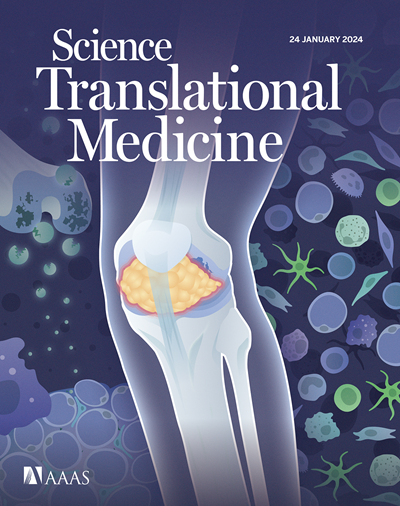Intra-amniotic antisense oligonucleotide treatment improves phenotypes in preclinical models of spinal muscular atrophy
IF 15.8
1区 医学
Q1 CELL BIOLOGY
引用次数: 0
Abstract
Neurological disorders with onset before or at birth are a leading cause of morbidity and mortality in infants and children. Prenatal treatment has the potential to reduce or prevent irreversible neuronal loss and facilitate normal neurodevelopment. We hypothesized that antisense oligonucleotides (ASOs) delivered to the amniotic fluid by intra-amniotic (IA) injection could safely distribute to the fetal central nervous system (CNS) and provide therapeutic benefit in the motor neuron disease spinal muscular atrophy (SMA), caused by mutations of the survival of motor neuron 1 gene (SMN1), leading to deficiency of SMN protein. Although the splice-switching ASO nusinersen ameliorates SMA when delivered postnatally, substantial deficits can remain in severely affected infants. Here, IA injection of ASOs into two mouse models of severe SMA increased SMN expression in the CNS. In SMAΔ7 mice, which manifest pathology in utero, prenatal treatment improved motor neuron numbers, motor axon development, motor behavioral tests, and survival when compared with those in mice treated postnatally (between P1 and P3). To assess the feasibility of prenatal treatment in a large-animal model, ASOs were delivered midgestation to fetal sheep by IA or intracranial injection. ASOs delivered by IA injection distributed to the spinal cord at therapeutic concentrations and to multiple peripheral tissues without evidence of substantial toxicity to the fetus or mother. These data demonstrated that IA delivery of ASOs holds potential as a minimally invasive approach for prenatal treatment of SMA and possibly other severe, early-onset neurological disorders.
羊膜内反义寡核苷酸治疗改善脊髓性肌萎缩症临床前模型的表型
在出生前或出生前发病的神经系统疾病是婴儿和儿童发病和死亡的主要原因。产前治疗有可能减少或防止不可逆的神经元损失和促进正常的神经发育。我们假设反义寡核苷酸(ASOs)通过羊膜内(IA)注射到羊水中可以安全地分布到胎儿中枢神经系统(CNS),并对运动神经元疾病脊髓性肌萎缩(SMA)提供治疗作用,该疾病是由运动神经元1基因(SMN1)存活突变引起的,导致SMN蛋白缺乏。虽然剪接开关ASO手术在产后分娩时可以改善SMA,但严重受损的婴儿仍可能存在严重缺陷。在这里,IA注射ASOs到两种严重SMA小鼠模型中,增加了CNS中SMN的表达。SMAΔ7小鼠在子宫内就表现出病理,与出生后(P1和P3之间)治疗的小鼠相比,产前治疗改善了运动神经元数量、运动轴突发育、运动行为测试和存活率。为了在大型动物模型中评估产前治疗的可行性,我们在妊娠中期通过IA或颅内注射将ASOs输送给胎羊。经IA注射的ASOs以治疗浓度分布于脊髓和多个外周组织,无证据表明对胎儿或母亲有实质性毒性。这些数据表明,在SMA和其他严重的早发性神经系统疾病的产前治疗中,IA输送ASOs具有作为一种微创方法的潜力。
本文章由计算机程序翻译,如有差异,请以英文原文为准。
求助全文
约1分钟内获得全文
求助全文
来源期刊

Science Translational Medicine
CELL BIOLOGY-MEDICINE, RESEARCH & EXPERIMENTAL
CiteScore
26.70
自引率
1.20%
发文量
309
审稿时长
1.7 months
期刊介绍:
Science Translational Medicine is an online journal that focuses on publishing research at the intersection of science, engineering, and medicine. The goal of the journal is to promote human health by providing a platform for researchers from various disciplines to communicate their latest advancements in biomedical, translational, and clinical research.
The journal aims to address the slow translation of scientific knowledge into effective treatments and health measures. It publishes articles that fill the knowledge gaps between preclinical research and medical applications, with a focus on accelerating the translation of knowledge into new ways of preventing, diagnosing, and treating human diseases.
The scope of Science Translational Medicine includes various areas such as cardiovascular disease, immunology/vaccines, metabolism/diabetes/obesity, neuroscience/neurology/psychiatry, cancer, infectious diseases, policy, behavior, bioengineering, chemical genomics/drug discovery, imaging, applied physical sciences, medical nanotechnology, drug delivery, biomarkers, gene therapy/regenerative medicine, toxicology and pharmacokinetics, data mining, cell culture, animal and human studies, medical informatics, and other interdisciplinary approaches to medicine.
The target audience of the journal includes researchers and management in academia, government, and the biotechnology and pharmaceutical industries. It is also relevant to physician scientists, regulators, policy makers, investors, business developers, and funding agencies.
 求助内容:
求助内容: 应助结果提醒方式:
应助结果提醒方式:


